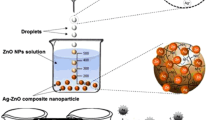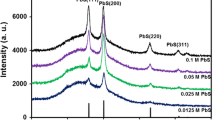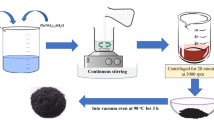Abstract
Structural, morphological, optical and electrical investigations of pure and Al-doped lead sulfide (PbS) nanoparticles hybrid composite was synthesized by simple chemical route. The detail analysis of the nanoparticle morphology of hybrid composites through optical investigation, phase purity and crystalline size had been characterized by using X-ray diffraction (XRD), scanning electron microscopy (SEM), transmission electron microscope (TEM), ultraviolet spectroscopy (UV), photoluminescence (PL). The lower angle XRD results confirmed that the phase purity and average crystalline size of the pure and Al doped PbS nanoparticles were determined by using the Debye–Scherrer’s formula. The average grain sizes of the pure and the Al-doped PbS nanoparticles were calculated and found to be 22 and 16 nm respectively. Surface morphology analysis was carried out by using SEM and TEM analysis. The surface morphology of pure and Al doped PbS nanoparticles is without any pinholes or cracks and hence they appear to be densely packed with spherical shaped grains. The optical properties of pure and Al-doped PbS analyzed using UV–Vis. absorption spectroscopy and Photoluminiscence (PL) spectra. The band gap values for the pure and the Al-doped PbS nanoparticles were found to be 1.94 and 2.04 eV respectively. The dielectric properties of the Al-doped PbS nanoparticle composites typical response e.g. dielectric constant, dielectric loss, and AC conductivity were analyzed at various frequencies and temperatures.













Similar content being viewed by others
References
X. Lu, I. Li, W. Zhang, C. Wang, Nanotechnology 16, 2233 (2005)
Z.I. Wang, Ann. Rev. Phys. Chem. 55, 159 (2004)
C. Rajashree, A.R Balu, V.S Nagarethinam, J. Mater. Sci. Mater. Electron. 27, 5070 (2016)
A.H. Souici, N. Keghouche, J.A. Delaire, H. Remita, A. Etcheberry, M. Mostafavi, J. Phys. Chem. C 113, 8050–8057 (2009)
J.D. Patel, F. Mighri, Mater. Sci. Appl. 3, 125–130 (2012)
X. Zhao, I. Gorelikov, J. Langmuir. 21, 1086–1090 (2005)
L.F. Koao, F.B. Dejene, H.C. Swart, Int J. Electrochem. Sci. 9, 1747–1757 (2014)
G.I. Koleilat, L. Levina, ACS Nano 2, 833–840 (2008)
A. Dumbrava, D. Berger, G. Prodan, F. Moscalu, A. Diacon, Mater. Chem. Phys. 173, 70 (2016)
T. Sivaraman, V. Narasimman, V.S. Nagarethinam, A.R. Balu, Prog. Nat. Sci. Mater. Int. 25, 392 (2015)
T. Sivaraman, V.S. Nagarethinam, A.R. Balu, K. Usharani, J. Mater. Sci. Mater. Electron. 27, 1158 (2016)
S.B. Pawar, J.S. Shaikh, R.S. Devan, Y.R. Ma, D. Heranath, P.N. Bhosale, P.S. Patil, Appl. Surf. Sci. 258, 1869 (2011)
Y. Al-Douri, Q. Khasawneh, S. Kiwan, U. Hasim, S.B. Abd Hamid, A.H. Reshak, A. Bouhemadou, M. Ameri, R. Khenata, Energy Convers. Manage. 82, 238 (2014)
S.J. Gnanamuthu, I.K. Punithavathy, S.J. Jeyakumar, K. Usharani, A.R. Balu, Mater. Res. Innov. 20, 398 (2016)
S. Sagadevan, I. Das, J. Podder, J. Mater. Sci. 27, 13016–13021 (2016)
S. Sagadevan, K. Pal, P. Koteeswari, A. Subashini, J. Mater. Sci. (2017). doi:10.1007/s10854-017-6488-3
D.M.D.M. Prabaharan, K. Sadaiyandi, M. Mahendran, S. Sagadevan, Mater. Res. 19, 478–482 (2016)
S. Sagadevan, I. Das, P. Singh, J. Podder, J. Mater. Sci. 28, 1136–1141 (2017)
S. Sagadevan, I. Das, K. Pal, P. Murugasen, P. Singh, J. Mater. Sci. (2016). doi:10.1007/s10854-016-6180-z
S. Sagadevana, J. Podder, Mater. Res. 19(2), 420–425, (2016)
R. Sharma, P. Pahuja, R.P. Tandon, Ceram. Int. 40, 9027–9036 (2014)
Author information
Authors and Affiliations
Corresponding author
Rights and permissions
About this article
Cite this article
Sagadevan, S., Pal, K., Hoque, E. et al. A chemical synthesized Al-doped PbS nanoparticles hybrid composite for optical and electrical response. J Mater Sci: Mater Electron 28, 10902–10908 (2017). https://doi.org/10.1007/s10854-017-6869-7
Received:
Accepted:
Published:
Issue Date:
DOI: https://doi.org/10.1007/s10854-017-6869-7




